Retrieval of Soil Moisture in the Yutian Oasis, Northwest China by 3D Feature Space Based on Optical and Radar Remote Sensing Data
Abstract
1. Introduction
2. Materials and Methods
2.1. Study Area
2.2. Soil Sampling and Analysis
2.3. Satellite Imagery and Preparation
2.4. Polarization Mode of SAR
2.5. Polarimetric Decomposition of SAR
2.6. Optical Remote Sensing Indices of Soil Moisture Response
2.7. Optimal Component Selection Method
2.8. Feature Space
3. Construction of Feature Spaces and Estimation Index
3.1. Optimal Feature Component Selection
3.2. Feature Space
3.2.1. HH-Vanzyl-MSAVI Feature Space
3.2.2. NDVI-Vanzyl-MSAVI Feature Space
3.2.3. Soil Moisture Estimation Index
4. Results
5. Discussion
5.1. Strengths and Potentials of This Study
5.2. Soil Moisture Distribution Characteristics Analysis
5.3. Limitations and Perspectives
6. Conclusions
- (1)
- Two feature spaces were constructed on the basis of the four scenarios of feature selection: the HH-Vanzyl-MSAVI 3D feature space was created by selecting HH, Vanzyl_g, and MSAVI from the polarization modes and their combinations, polarimetric decomposition scattering components, and optical remote sensing indices, respectively; the other NDVI-Vanzyl-MSAVI 3D feature space was constructed by selecting van Zyl, MSAVI, and NDVI from all optical and radar components. The results showed a positive correlation between the individual components of both 3D feature spaces.
- (2)
- The ORSMRI, based on both radar and optical remote sensing data, was proposed by analyzing the distribution of soil moisture in the 3D feature space. A total of 60 samples were randomly selected and used for fitting with the ORSMRI to verify its accuracy. The results showed that the R2 values for ORSMRI 1 and ORSMRI 2 were 0.797 and 0.721, and RMSE values were 3.329% and 3.905%, respectively. To further analyze soil moisture and its distribution in the study area, the retrieval of soil moisture was performed using the proposed ORSMRI, and the linear correlation between the retrieved and measured soil moisture was examined. A correlation test between the retrieved soil moisture and the remaining measured soil moisture for the same period revealed that the Pearson correlation coefficients for ORSMRI 1 and ORSMRI 2 were 0.71 and 0.70, respectively, with a significance level of 1%, which confirms the effectiveness of the ORSMRI proposed in this study.
- (3)
- Yutian Oasis is a typical arid and semi-arid oasis located inland, where the soil moisture distribution exhibits a hierarchical and alternating pattern. The distribution of soil moisture shows a trend of being higher in the south than in the north, and higher in the west than in the east. Areas with low soil moisture are concentrated in the deserts and Gobi in the southwestern and northern (especially northeastern) parts of the oasis’s periphery, while areas with high soil moisture are concentrated in the southeastern and central-western regions of the oasis, which are primarily covered by vegetation and farmland.
Author Contributions
Funding
Data Availability Statement
Acknowledgments
Conflicts of Interest
References
- Avissar, R. Which type of soil–vegetation–atmosphere transfer scheme is needed for general circulation models: A proposal for a higher–order scheme. J. Hydrol. 1998, 212–213, 136–154. [Google Scholar] [CrossRef]
- Baghdadi, N.; Cresson, R.; Pottier, E.; Aubert, M.; Mehrez, M.; Jacome, A.; Benabdallah, S. A Potential Use for the C-Band Polarimetric SAR Parameters to Characterize the Soil Surface Over Bare Agriculture Fields. IEEE Trans. Geosci. Remote Sens. 2012, 50, 3844–3858. [Google Scholar] [CrossRef]
- Beck, H.E.; de Jeu, R.A.M.; Schellekens, J.; van Dijk, A.I.J.M.; Bruijnzeel, L.A. Improving Curve Number Based Storm Runoff Estimates Using Soil Moisture Proxies. IEEE J. Sel. Top. Appl. Earth Obs. Remote Sens. 2009, 2, 250–259. [Google Scholar] [CrossRef]
- Yang, T.; Gong, H.; Li, X.; Zhao, W.; Meng, D. Progress of soil moisture monitoring by remote sensing. Acta Ecol. Sin. 2010, 30, 6264–6277. [Google Scholar]
- Walker, J. Estimating Soil Moisture Profile Dynamics from Near-Surface Soil Moisture Measurements and Standard Metrological Data. Ph.D. Thesis, The University of Newcastle, Newcastle, NSW, Australia, 1999. [Google Scholar]
- Lo, M.-H.; Famiglietti, J.S. Irrigation in California’s Central Valley strengthens the southwestern U.S. water cycle. Geophys. Res. Lett. 2013, 40, 301–306. [Google Scholar] [CrossRef]
- Hong, Z.; Zhang, W.; Yu, C.; Zhang, D.; Li, L.; Meng, L. SWCTI: Surface Water Content Temperature Index for Assessment of Surface Soil Moisture Status. Sensors 2018, 18, 2875. [Google Scholar] [CrossRef] [PubMed]
- Yin, Z.; Lei, T.; Yan, Q.; Chen, Z.; Dong, Y. A near-infrared reflectance sensor for soil surface moisture measurement. Comput. Electron. Agric. 2013, 99, 101–107. [Google Scholar] [CrossRef]
- Wang, Y.; Yang, J.; Chen, Y.; Wang, A.; De Maeyer, P. The Spatiotemporal Response of Soil Moisture to Precipitation and Temperature Changes in an Arid Region, China. Remote Sens. 2018, 10, 468. [Google Scholar] [CrossRef]
- Pierdicca, N.; Fascetti, F.; Pulvirenti, L.; Crapolicchio, R.; Muñoz-Sabater, J. Analysis of ASCAT, SMOS, in-situ and land model soil moisture as a regionalized variable over Europe and North Africa. Remote Sens. Environ. 2015, 170, 280–289. [Google Scholar] [CrossRef]
- Zhao, W.; Liu, B. The response of sap flow in shrubs to rainfall pulses in the desert region of China. Agric. For. Meteorol. 2010, 150, 1297–1306. [Google Scholar] [CrossRef]
- Gao, J.; Wang, W.; Zhao, M.; Ma, Z.; Hou, X.; Li, W. Spatial and temporal distribution characteristics of soil moisture in the non-freezing period under the bare land and vegetation cover in the Mu Us desert. Hydrogeol. Eng. Geol. 2022, 49, 34–42. [Google Scholar] [CrossRef]
- Hu, D.; Guo, N.; Sha, S.; Wang, L.; Li, Q.; Wang, J.; Liu, W. Retrieval of Bare Soil Moisture Based on Radarsat-2 SAR in Dingxi of Gansu Provine. J. Arid Meteorol. 2014, 32, 553–559. [Google Scholar]
- Procházka, P.; Hönig, V.; Maitah, M.; Pljučarská, I.; Kleindienst, J. Evaluation of Water Scarcity in Selected Countries of the Middle East. Water 2018, 10, 1482. [Google Scholar] [CrossRef]
- Feng, S.; Fu, Q. Expansion of global drylands under a warming climate. Atmos. Chem. Phys. 2013, 13, 10081–10094. [Google Scholar] [CrossRef]
- Liang, X.; Lettenmaier, D.P.; Wood, E.F.; Burges, S.J. A simple hydrologically based model of land surface water and energy fluxes for general circulation models. J. Geophys. Res. Atmos. 2012, 99, 14415–14428. [Google Scholar] [CrossRef]
- Xi, W.; Zhan, W.; Wentao, Y.; Xuejie, X.; Longyue, S.; Wenyue, D.; Qian, Z.; Yuenan, Z. Shortage of Water Resources in CHINA and Countermeasures. Environ. Eng. 2014, 32, 1–5. [Google Scholar] [CrossRef]
- Chen, Y.; Li, Z.; Xu, J.; Shen, Y.; Xing, X.; Xie, T.; Li, Z.; Yang, L.; Xi, H.; Zhu, C.; et al. Changes and Protection Suggestions in Water Resources and Ecological Environment in Arid Region of Northwest China. Bull. Chin. Acad. Sci. 2023, 38, 385–393. [Google Scholar]
- Chen, Y. Research on Water Resources in the Arid Areas of Northwest China; Science Press: Beijing, China, 2014. [Google Scholar]
- Wu, M.-C.; Ding, J.-L.; Wang, G.-F. Regional Soil Moisture Inversion Based on Surface Temperature and Vegetation Index Characteristic Spaces. J. Desert Res. 2012, 32, 148–154. [Google Scholar]
- Guo, B.; Zang, W.; Zhang, R. Soil Salizanation Information in the Yellow River Delta Based on Feature Surface Models Using Landsat 8 OLI Data. IEEE Access 2020, 8, 94394–94403. [Google Scholar] [CrossRef]
- Escorihuela, M.J.; Quintana-Seguí, P. Comparison of remote sensing and simulated soil moisture datasets in Mediterranean landscapes. Remote Sens. Environ. 2016, 180, 99–114. [Google Scholar] [CrossRef]
- Shi, J.; Du, Y.; Du, J.; Jiang, L.; Chai, L.; Mao, K.; Xu, P.; Ni, W.; Xiong, C.; Liu, Q.; et al. Progresses on microwave remote sensing of land surface parameters. Sci. China Earth Sci. 2012, 55, 1052–1078. [Google Scholar] [CrossRef]
- Ilyas, N.; Shi, Q.; Abdulla, A.; Xia, N.; Wang, J. Quantitative evaluation of soil salinization risk in Keriya Oasis based on grey evaluation model. Trans. Chin. Soc. Agric. Eng. 2019, 35, 176–184. [Google Scholar] [CrossRef]
- Boerner, W.M. Recent advances in extra-wide-band polarimetry, interferometry and polarimetric interferometry in synthetic aperture remote sensing and its applications. IEE Proc.-Radar Sonar Navig. 2003, 150, 113–124. [Google Scholar] [CrossRef]
- Hajnsek, I.; Jagdhuber, T.; Schon, H.; Papathanassiou, K.P. Potential of Estimating Soil Moisture Under Vegetation Cover by Means of PolSAR. IEEE Trans. Geosci. Remote Sens. 2009, 47, 442–454. [Google Scholar] [CrossRef]
- Tripathi, A.; Tiwari, R.K. Synergetic utilization of sentinel-1 SAR and sentinel-2 optical remote sensing data for surface soil moisture estimation for Rupnagar, Punjab, India. Geocarto Int. 2020, 37, 2215–2236. [Google Scholar] [CrossRef]
- Huang, S.; Ding, J.; Liu, B.; Ge, X.; Wang, J.; Zou, J.; Zhang, J. The Capability of Integrating Optical and Microwave Data for Detecting Soil Moisture in an Oasis Region. Remote Sens. 2020, 12, 1358. [Google Scholar] [CrossRef]
- Lievens, H.; Verhoest, N.E.C. Spatial and temporal soil moisture estimation from RADARSAT-2 imagery over Flevoland, The Netherlands. J. Hydrol. 2012, 456-457, 44–56. [Google Scholar] [CrossRef]
- Sandholt, I.; Rasmussen, K.; Andersen, J. A simple interpretation of the surface temperature/vegetation index space for assessment of surface moisture status. Remote Sens. Environ. 2002, 79, 213–224. [Google Scholar] [CrossRef]
- Carlson, T.N.; Gillies, R.R.; Perry, E.M. A method to make use of thermal infrared temperature and NDVI measurements to infer surface soil water content and fractional vegetation cover. Remote Sens. Rev. 1994, 9, 161–173. [Google Scholar] [CrossRef]
- Clarke, T.R. An Empirical Approach for Detecting Crop Water Stress Using Multispectral Airborne Sensors. HortTechnology 1997, 7, 9–16. [Google Scholar] [CrossRef]
- Goetz, S.J. Multi-sensor analysis of NDVI, surface temperature and biophysical variables at a mixed grassland site. Int. J. Remote Sens. 2010, 18, 71–94. [Google Scholar] [CrossRef]
- Lambin, E.F.; Ehrlich, D. The surface temperature-vegetation index space for land cover and land-cover change analysis. Int. J. Remote Sens. 2007, 17, 463–487. [Google Scholar] [CrossRef]
- Ghulam, A.; Qin, Q.; Zhan, Z. Designing of the perpendicular drought index. Environ. Geol. 2006, 52, 1045–1052. [Google Scholar] [CrossRef]
- Liu, Y.; Wu, L.; Yue, H. Biparabolic NDVI-Ts Space and Soil Moisture Remote Sensing in an Arid and Semi arid Area. Can. J. Remote Sens. 2015, 41, 159–169. [Google Scholar] [CrossRef]
- Pandey, R.; Goswami, S.; Sarup, J.; Matin, S. The thermal–optical trapezoid model-based soil moisture estimation using Landsat-8 data. Model. Earth Syst. Environ. 2020, 7, 1029–1037. [Google Scholar] [CrossRef]
- Becaro Crioni, P.L.; Hideo Teramoto, E.; Favoreto da Cunha, C.; Chang, H.K. Evaluation of the OPTRAM Using Sentinel-2 Imagery to Estimate Soil Moisture in Urban Environments. Rev. Bras. Geogr. Física 2025, 18, 605–621. [Google Scholar] [CrossRef]
- Singh, A.; Meena, G.K.; Kumar, S.; Gaurav, K. Evaluation of the Penetration Depth of L- and S-Band (NISAR mission) Microwave SAR Signals into Ground. In Proceedings of the 2019 URSI Asia-Pacific Radio Science Conference (AP-RASC), New Delhi, India, 9–15 March 2019; p. 1. [Google Scholar]
- Huete, A.R.; Warrick, A.W. Assessment of vegetation and soil water regimes in partial canopies with optical remotely sensed data. Remote Sens. Environ. 1990, 32, 155–167. [Google Scholar] [CrossRef]
- Deng, B.; Wahap, H.; Dang, J.; Zhang, Y.; Xuan, J. Coupled analysis of spafio-temporal variability of groundwater depth and soil salinity in Keriya Oasi. Arid. Land Geogr. 2015, 38, 599–607. [Google Scholar] [CrossRef]
- Nurmemet, I.; Sagan, V.; Ding, J.-L.; Halik, Ü.; Abliz, A.; Yakup, Z. A WFS-SVM Model for Soil Salinity Mapping in Keriya Oasis, Northwestern China Using Polarimetric Decomposition and Fully PolSAR Data. Remote Sens. 2018, 10, 598. [Google Scholar] [CrossRef]
- Wang, Q. The Couping Relationship Between SoilWater Content and the Buried Depth of Ground Water on Yutian Oasis. Master’s Thesis, Xinjinang University, Urumqi, China, 2011. [Google Scholar]
- Wang, F.; Yang, S.; Yang, W.; Yang, X.; Jianli, D. Comparison of machine learning algorithms for soil salinity predictions in three dryland oases located in Xinjiang Uyghur Autonomous Region (XJUAR) of China. Eur. J. Remote Sens. 2019, 52, 256–276. [Google Scholar] [CrossRef]
- Yan-bing, P.; Dun-peng, L.; Fang-fang, G.; Zhe-feng, H.; Jun-ling, P.; Jian, L.; Yue, Z. Geomorphological features of the Keriya River valley and the early-middle Pleistocene great lake of the Tarim basin. Geol. Bull. China 2008, 27, 814–822. [Google Scholar] [CrossRef]
- Ling, H.-B.; Xu, H.-L.; Liu, X.-H.; Zhang, Q.-Q.; Fu, J.-Y.; Bai, Y. Suitable scale of oasis in Keriya River basin, Xinjiang. Adv. Water Sci. 2012, 23, 563–568. [Google Scholar] [CrossRef]
- Wang, F.; Ding, J.; Wu, M. Remote sensing monitoring models of soil salinization based on NDVI-SI feature space. Trans. Chin. Soc. Agric. Eng. 2010, 26, 168–173. [Google Scholar] [CrossRef]
- Muhetaer, N.; Nurmemet, I.; Abulaiti, A.; Xiao, S.; Zhao, J. A Quantifying Approach to Soil Salinity Based on a Radar Feature Space Model Using ALOS PALSAR-2 Data. Remote Sens. 2022, 14, 363. [Google Scholar] [CrossRef]
- Ali, Z.; Barnard, I.; Fox, P.; Duggan, P.; Gray, R.; Allan, P.; Brand, A.; Ste-Mari, R. Description of RADARSAT-2 synthetic aperture radar design. Can. J. Remote Sens. 2014, 30, 246–257. [Google Scholar] [CrossRef]
- Baillarin, S.J.; Meygret, A.; Dechoz, C.; Petrucci, B.; Lacherade, S.; Tremas, T.; Isola, C.; Martimort, P.; Spoto, F. Sentinel-2 Level 1 Products and Image Processing Performances. Int. Arch. Photogramm. Remote Sens. Spat. Inf. Sci. 2012, XXXIX-B1, 197–202. [Google Scholar] [CrossRef]
- Acar, H.; Ozerdem, M.S.; Acar, E. Soil Moisture Inversion Via Semiempirical and Machine Learning Methods with Full-Polarization Radarsat-2 and Polarimetric Target Decomposition Data: A Comparative Study. IEEE Access 2020, 8, 197896–197907. [Google Scholar] [CrossRef]
- Ma, C.; Li, X.; McCabe, M.F. Retrieval of High-Resolution Soil Moisture through Combination of Sentinel-1 and Sentinel-2 Data. Remote Sens. 2020, 12, 2303. [Google Scholar] [CrossRef]
- Jong-Sen, L.; Grunes, M.R.; Pottier, E. Quantitative comparison of classification capability: Fully polarimetric versus dual and single-polarization SAR. IEEE Trans. Geosci. Remote Sens. 2001, 39, 2343–2351. [Google Scholar] [CrossRef]
- Boerner, W.M.; Mott, H.; Luneburg, E. Polarimetry in remote sensing: Basic and applied concepts. In Proceedings of the IGARSS’97, 1997 IEEE International Geoscience and Remote Sensing Symposium Proceedings, Remote Sensing—A Scientific Vision for Sustainable Development, Singapore, 3–8 August 1997; Volume 1403, pp. 1401–1403. [Google Scholar]
- Merzouki, A.; McNairn, H.; Pacheco, A. Mapping Soil Moisture Using RADARSAT-2 Data and Local Autocorrelation Statistics. IEEE J. Sel. Top. Appl. Earth Obs. Remote Sens. 2011, 4, 128–137. [Google Scholar] [CrossRef]
- Ulaby, F.T.; Bradley, G.A.; Dobson, M.C. Microwave Backscatter Dependence on Surface Roughness, Soil Moisture, and Soil Texture: Part II-Vegetation-Covered Soil. IEEE Trans. Geosci. Electron. 1979, 17, 33–40. [Google Scholar] [CrossRef]
- Holah, N.; Baghdadi, N.; Zribi, M.; Bruand, A.; King, C. Potential of ASAR/ENVISAT for the characterization of soil surface parameters over bare agricultural fields. Remote Sens. Environ. 2005, 96, 78–86. [Google Scholar] [CrossRef]
- Junzhan, W.; Yansong, B.; Youjing, Z.; Jianjun, Q.; Weimin, Z. Soil moisture inversion multi-polarization and multi angle ENVISAT ASAR data in surface soils of bare area and wheat-covered area. Trans. Chin. Soc. Agric. Eng. 2010, 26, 205–210. [Google Scholar] [CrossRef]
- Jakob, J.v.Z. Application of Cloude’s target decomposition theorem to polarimetric imaging radar data. Proc.SPIE 1993, 1748, 184–191. [Google Scholar] [CrossRef]
- Huynen, J.R. Phenomenological Theory of Radar Targets. In Electromagnetic Scattering; Uslenghi, P.L.E., Ed.; Academic Press: Cambridge, MA, USA, 1978. [Google Scholar]
- Wentao, A.; Yi, C.; Jian, Y. Three-Component Model-Based Decomposition for Polarimetric SAR Data. IEEE Trans. Geosci. Remote Sens. 2010, 48, 2732–2739. [Google Scholar] [CrossRef]
- Krogager, E.; Boerner, W.-M.; Madsen, S. Feature-motivated Sinclair matrix (sphere/diplane/helix) decomposition and its application to target sorting for land feature classification. Proc. SPIE-Int. Soc. Opt. Eng. 1997, 3120, 144–154. [Google Scholar] [CrossRef]
- Cloude, S.R.; Pottier, E. A review of target decomposition theorems in radar polarimetry. IEEE Trans. Geosci. Remote Sens. 1996, 34, 498–518. [Google Scholar] [CrossRef]
- Yang, J.; Yamaguchi, Y.; Yamada, H.; Sengoku, M.; Lin, S. Stable Decomposition of Mueller Matrix. IEICE Trans. Commun. 1998, E81-B, 1261–1268. [Google Scholar]
- Yamaguchi, Y.; Moriyama, T.; Ishido, M.; Yamada, H. Four-component scattering model for polarimetric SAR image decomposition. IEEE Trans. Geosci. Remote Sens. 2005, 43, 1699–1706. [Google Scholar] [CrossRef]
- Krogager, E. Aspects of Polarimetric Radar Imaging; Danish Defence Research Establishment: Copenhagen, Denmark, 1993. [Google Scholar]
- Xie, Q.; Meng, Q.; Zhang, L.; Wang, C.; Sun, Y.; Sun, Z. A Soil Moisture Retrieval Method Based on Typical Polarization Decomposition Techniques for a Maize Field from Full-Polarization Radarsat-2 Data. Remote Sens. 2017, 9, 168. [Google Scholar] [CrossRef]
- Li, Z.; Lindenschmidt, K.-E. Monitoring river ice cover development using the Freeman–Durden decomposition of quad-pol Radarsat-2 images. J. Appl. Remote Sens. 2018, 12, 026014. [Google Scholar] [CrossRef]
- Banerjee, B.; Bhattacharya, A.; Buddhiraju, K.M. A Generic Land-Cover Classification Framework for Polarimetric SAR Images Using the Optimum Touzi Decomposition Parameter Subset—An Insight on Mutual Information-Based Feature Selection Techniques. IEEE J. Sel. Top. Appl. Earth Obs. Remote Sens. 2014, 7, 1167–1176. [Google Scholar] [CrossRef]
- Muhetaer, N.; Nurmemet, I.; Abulaiti, A.; Xiao, S.; Zhao, J. An Efficient Approach for Inverting the Soil Salinity in Keriya Oasis, Northwestern China, Based on the Optical-Radar Feature-Space Model. Sensors 2022, 22, 7226. [Google Scholar] [CrossRef]
- Freeman, A.; Durden, S.L. A three-component scattering model for polarimetric SAR data. IEEE Trans. Geosci. Remote Sens. 1998, 36, 963–973. [Google Scholar] [CrossRef]
- Varghese, A.O.; Suryavanshi, A.; Joshi, A.K. Analysis of different polarimetric target decomposition methods in forest density classification using C band SAR data. Int. J. Remote Sens. 2016, 37, 694–709. [Google Scholar] [CrossRef]
- Touzi, R. Polarimetric Target Scattering Decomposition: A Review; IEEE: Piscataway, NJ, USA, 2016; pp. 5658–5661. [Google Scholar]
- Zhang, L.; Meng, Q.; Zeng, J.; Wei, X.; Shi, H. Evaluation of Gaofen-3 C-Band SAR for Soil Moisture Retrieval Using Different Polarimetric Decomposition Models. IEEE J. Sel. Top. Appl. Earth Obs. Remote Sens. 2021, 14, 5707–5719. [Google Scholar] [CrossRef]
- Anconitano, G.; Lavalle, M.; Acuña, M.A.; Pierdicca, N. Sensitivity of Polarimetric SAR Decompositions to Soil Moisture and Vegetation Over Three Agricultural Sites Across a Latitudinal Gradient. IEEE J. Sel. Top. Appl. Earth Obs. Remote Sens. 2024, 17, 3615–3634. [Google Scholar] [CrossRef]
- Yang, L.; Feng, X.; Liu, F.; Liu, J.; Sun, X. Potential of soil moisture estimation using C-band polarimetric SAR data in arid regions. Int. J. Remote Sens. 2018, 40, 2138–2150. [Google Scholar] [CrossRef]
- Wang, H.; Magagi, R.; Goita, K. Comparison of different polarimetric decompositions for soil moisture retrieval over vegetation covered agricultural area. Remote Sens. Environ. 2017, 199, 120–136. [Google Scholar] [CrossRef]
- Huang, X.; Ziniti, B.; Cosh, M.H.; Reba, M.; Wang, J.; Torbick, N. Field-Scale Soil Moisture Retrieval Using PALSAR-2 Polarimetric Decomposition and Machine Learning. Agronomy 2020, 11, 35. [Google Scholar] [CrossRef]
- Joseph, A.S.; Paul, W.N.; Nathan, A.K.; Nathan, J.P.; Devin, M.; Cassie, K.; Nathan, F.; Randal, M.L.; Angela, C.D.; Knighton, W.B. Multispectral imaging systems on tethered balloons for optical remote sensing education and research. J. Appl. Remote Sens. 2012, 6, 063613. [Google Scholar] [CrossRef]
- Liu, Z.; Zheng, J.; Zhu, Z.; Qu, Y.; Xu, Z. Applicability Research of Parameters in Soil Moisture Inversion. Geogr. Sci. Res. 2022, 11, 395–406. [Google Scholar] [CrossRef]
- Ling, C.-X.; Zhang, H.-Q.; Ju, H.-B.; Sun, H. Research on Vegetation Fractional Coverage Estimation of NDVI-Dimidiate Pixel Model based on Worldview-2 Data. In Proceedings of the 2012 International Conference on Earth Science and Remote Sensing (ESRS 2012), Hong Kong, China, 4–5 September 2012; pp. 120–127. [Google Scholar]
- Wang, X.; Xie, S.; Du, J. Water index formulation and its effectiveness research on the complicated surface water surroundings. J. Remote Sens. 2018, 22, 360–372. [Google Scholar] [CrossRef]
- Wang, L.; Qu, J.J. NMDI: A normalized multi-band drought index for monitoring soil and vegetation moisture with satellite remote sensing. Geophys. Res. Lett. 2007, 34, L20405. [Google Scholar] [CrossRef]
- Olsen, J.; Ceccato, P.; Proud, S.; Fensholt, R.; Grippa, M.; Mougin, E.; Ardö, J.; Sandholt, I. Relation between Seasonally Detrended Shortwave Infrared Reflectance Data and Land Surface Moisture in Semi-Arid Sahel. Remote Sens. 2013, 5, 2898–2927. [Google Scholar] [CrossRef]
- Patel, N.R.; Anapashsha, R.; Kumar, S.; Saha, S.K.; Dadhwal, V.K. Assessing potential of MODIS derived temperature/vegetation condition index (TVDI) to infer soil moisture status. Int. J. Remote Sens. 2008, 30, 23–39. [Google Scholar] [CrossRef]
- Casamitjana, M.; Torres-Madroñero, M.C.; Bernal-Riobo, J.; Varga, D. Soil Moisture Analysis by Means of Multispectral Images According to Land Use and Spatial Resolution on Andosols in the Colombian Andes. Appl. Sci. 2020, 10, 5540. [Google Scholar] [CrossRef]
- McFeeters, S.K. The use of the Normalized Difference Water Index (NDWI) in the delineation of open water features. Int. J. Remote Sens. 2007, 17, 1425–1432. [Google Scholar] [CrossRef]
- Xu, H. Modification of normalised difference water index (NDWI) to enhance open water features in remotely sensed imagery. Int. J. Remote Sens. 2007, 27, 3025–3033. [Google Scholar] [CrossRef]
- Gu, Y.; Hunt, E.; Wardlow, B.; Basara, J.B.; Brown, J.F.; Verdin, J.P. Evaluation of MODIS NDVI and NDWI for vegetation drought monitoring using Oklahoma Mesonet soil moisture data. Geophys. Res. Lett. 2008, 35, L22401. [Google Scholar] [CrossRef]
- Yun-Jun, Y.; Qi-Ming, Q.; Shao-Hua, Z.; Wei-Lin, Y. Retrieval of soil moisture based on MODIS shortwave infrared spectral feature. J. Infrared Millim. Waves 2011, 30, 9. [Google Scholar]
- Xiao, D.; Shixin, W.; Yi, Z.; Hua, W. Construction and Validation of a New Model for Unified Surface Water Capacity Based on MODIS Data. Geomat. Inf. Sci. Wuhan Univ. 2017, 32, 205–207. [Google Scholar]
- Tucker, C.J. Red and photographic infrared linear combinations for monitoring vegetation. Remote Sens. Environ. 1979, 8, 127–150. [Google Scholar] [CrossRef]
- Gitelson, A.A.; Kaufman, Y.J.; Merzlyak, M.N. Use of a green channel in remote sensing of global vegetation from EOS-MODIS. Remote Sens. Environ. 1996, 58, 289–298. [Google Scholar] [CrossRef]
- Huete, A.R. A soil-adjusted vegetation index (SAVI). Remote Sens. Environ. 1988, 25, 295–309. [Google Scholar] [CrossRef]
- Qi, J.; Chehbouni, A.; Huete, A.R.; Kerr, Y.H.; Sorooshian, S. A modified soil adjusted vegetation index. Remote Sens. Environ. 1994, 48, 119–126. [Google Scholar] [CrossRef]
- Yin, Q.; Hong, W.; Zhang, F.; Pottier, E. Optimal Combination of Polarimetric Features for Vegetation Classification in PolSAR Image. IEEE J. Sel. Top. Appl. Earth Obs. Remote Sens. 2019, 12, 3919–3931. [Google Scholar] [CrossRef]
- Strobl, C.; Boulesteix, A.-L.; Zeileis, A.; Hothorn, T. Bias in random forest variable importance measures: Illustrations, sources and a solution. BMC Bioinform. 2007, 8, 25. [Google Scholar] [CrossRef] [PubMed]
- Das, B.; Rathore, P.; Roy, D.; Chakraborty, D.; Jatav, R.S.; Sethi, D.; Kumar, P. Comparison of bagging, boosting and stacking algorithms for surface soil moisture mapping using optical-thermal-microwave remote sensing synergies. Catena 2022, 217, 106485. [Google Scholar] [CrossRef]
- Zhang, F.; Zhang, L.-W.; Shi, J.-J.; Huang, J.-F. Soil Moisture Monitoring Based on Land Surface Temperature-Vegetation Index Space Derived from MODIS Data. Pedosphere 2014, 24, 450–460. [Google Scholar] [CrossRef]
- Sadeghi, M.; Babaeian, E.; Tuller, M.; Jones, S.B. The optical trapezoid model: A novel approach to remote sensing of soil moisture applied to Sentinel-2 and Landsat-8 observations. Remote Sens. Environ. 2017, 198, 52–68. [Google Scholar] [CrossRef]
- Carlson, T.N.; Petropoulos, G.P. A new method for estimating of evapotranspiration and surface soil moisture from optical and thermal infrared measurements: The simplified triangle. Int. J. Remote Sens. 2019, 40, 7716–7729. [Google Scholar] [CrossRef]
- Kulkarni, S.C.; Rege, P.P. Pixel level fusion techniques for SAR and optical images: A review. Inf. Fusion 2020, 59, 13–29. [Google Scholar] [CrossRef]
- Ayari, E.; Kassouk, Z.; Lili-Chabaane, Z.; Baghdadi, N.; Zribi, M. Investigation of Multi-Frequency SAR Data to Retrieve the Soil Moisture within a Drip Irrigation Context Using Modified Water Cloud Model. Sensors 2022, 22, 580. [Google Scholar] [CrossRef]
- Zhang, Q.-L.; Yin, H.; Ji, R.-P.; Wu, J.-W.; Zhang, H.-X. Retrieving on Monthly Soil Moisture in Liaoning Province Based on NDVI-LST Module. Chin. J. Agrometeorol. 2017, 38, 720–728. [Google Scholar] [CrossRef]
- Yuan, L.; Li, L.; Zhang, T.; Chen, L.; Zhao, J.; Hu, S.; Cheng, L.; Liu, W. Soil Moisture Estimation for the Chinese Loess Plateau Using MODIS-derived ATI and TVDI. Remote Sens. 2020, 12, 3040. [Google Scholar] [CrossRef]
- Guo, B.; Zang, W.; Han, B.; Yang, F.; Luo, W.; He, T.; Fan, Y.; Yang, X.; Chen, S. Dynamic monitoring of desertification in Naiman Banner based on feature space models with typical surface parameters derived from LANDSAT images. Land Degrad. Dev. 2020, 31, 1573–1592. [Google Scholar] [CrossRef]
- Guo, X.; Fu, Q.; Hang, Y.; Lu, H.; Gao, F.; Si, J. Spatial Variability of Soil Moisture in Relation to Land Use Types and Topographic Features on Hillslopes in the Black Soil (Mollisols) Area of Northeast China. Sustainability 2020, 12, 3352. [Google Scholar] [CrossRef]
- Liu, Y.; Qian, J.; Yue, H. Comparison and evaluation of different dryness indices based on vegetation indices-land surface temperature/albedo feature space. Adv. Space Res. 2021, 68, 2791–2803. [Google Scholar] [CrossRef]
- Cheng, L.; Liu, S.; Mo, X.; Hu, S.; Zhou, H.; Xie, C.; Nielsen, S.; Grosen, H.; Bauer-Gottwein, P. Assessing the Potential of 10-m Resolution TVDI Based on Downscaled LST to Monitor Soil Moisture in Tang River Basin, China. Remote Sens. 2023, 15, 744. [Google Scholar] [CrossRef]
- Ma, Y.; Liu, H.; Zhao, W.; Guo, L.; Yang, Q.; Li, Y.; Liu, J.; Yetemen, O. Responses of Soil Water Potential and Plant Physiological Status to Pulsed Rainfall Events in Arid Northwestern China: Implications for Disclosing the Water-Use Strategies of Desert Plants. Ecohydrology 2024, e2728. [Google Scholar] [CrossRef]
- Yang, T.; Ala, M.; Guan, D.; Wang, A. The Effects of Groundwater Depth on the Soil Evaporation in Horqin Sandy Land, China. Chin. Geogr. Sci. 2021, 31, 727–734. [Google Scholar] [CrossRef]
- Zhang, K.-G.; Ba, M.-T.; Meng, H.-L.; Sun, Y.-M. Characteristics Analysis of Land Use Spatial Distribution on Terrain Gradient in Henan Province. DEStech Trans. Comput. Sci. Eng. 2018, 96–102. [Google Scholar] [CrossRef] [PubMed]
- Zhuang, J.; Du, C.; Kong, J.; Zhu, Y.; Peng, J. A simplified calculation method for high-steep soil slope stability due to groundwater rise from irrigation. Geocarto Int. 2024, 39, 2408332. [Google Scholar] [CrossRef]
- Jiang, H.; Jiang, H.; Ding, J. Effect factors on soil moisture tempo-spatial variability of Yutian Oasis in arid area of China. J. Arid Land Resour. Environ. 2017, 31, 136–142. [Google Scholar] [CrossRef]
- Xiao, S.; Nurmemet, I.; Zhao, J. Soil salinity estimation based on machine learning using the GF-3 radar and Landsat-8 data in the Keriya Oasis, Southern Xinjiang, China. Plant Soil 2023, 498, 451–469. [Google Scholar] [CrossRef]
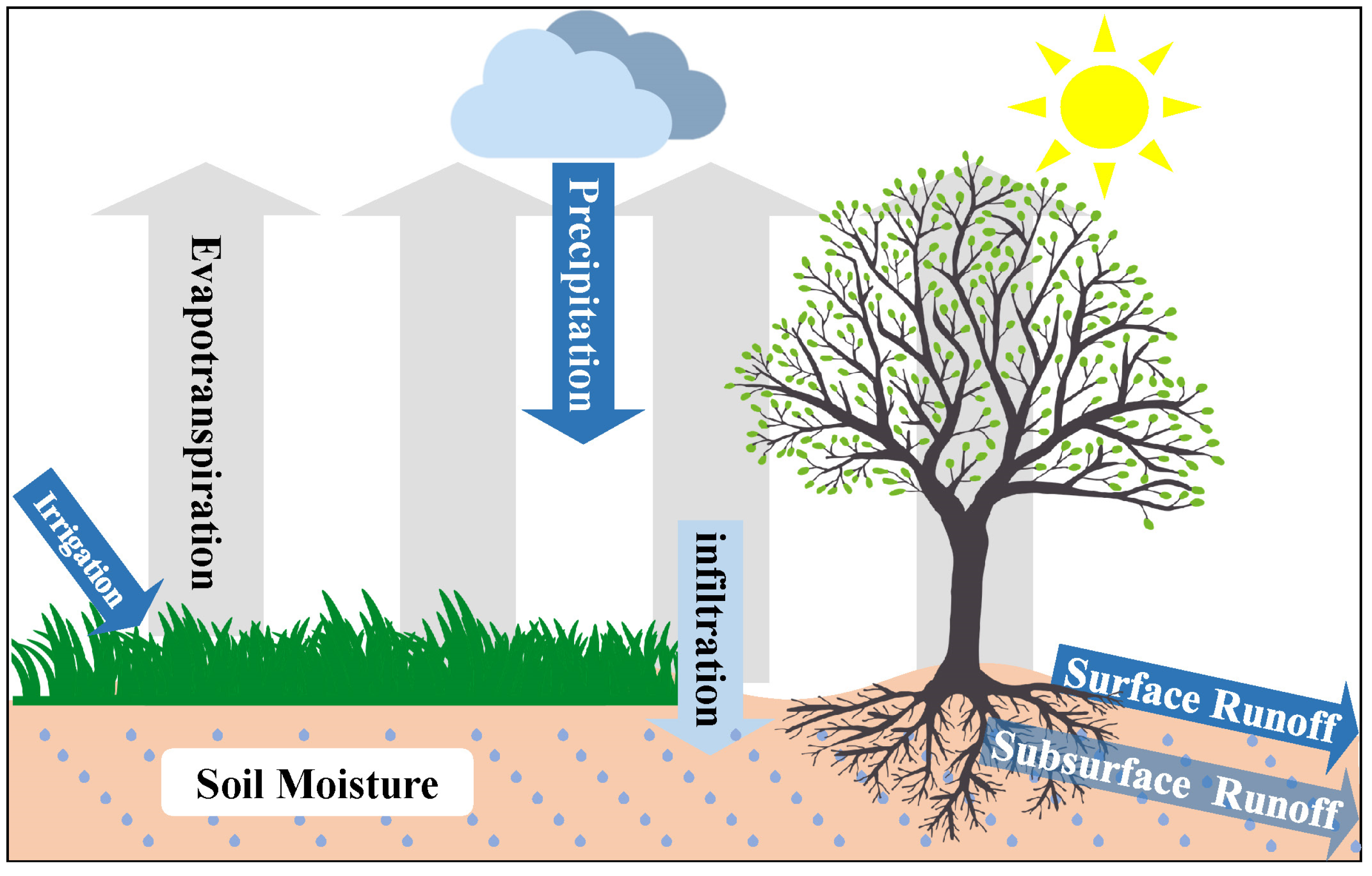
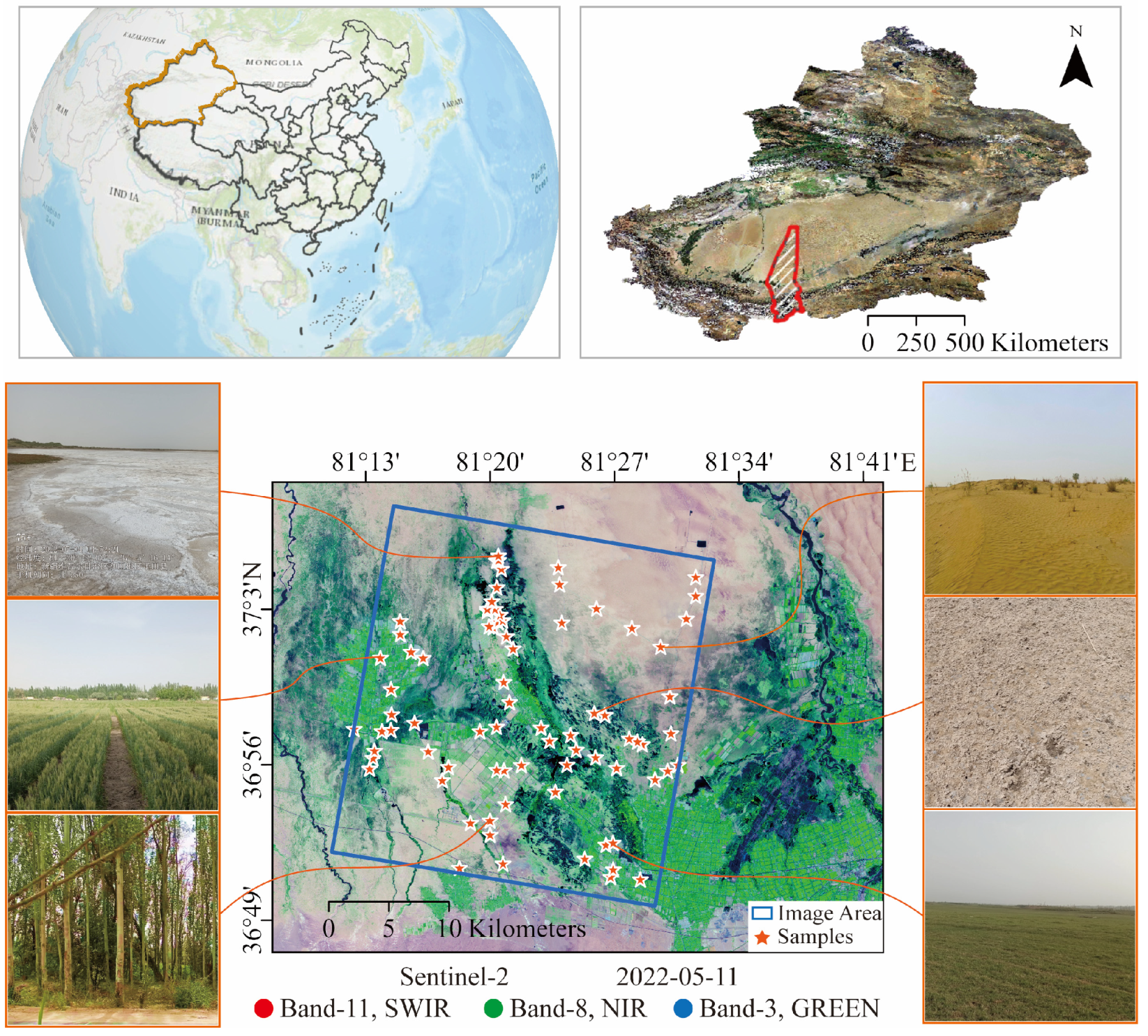
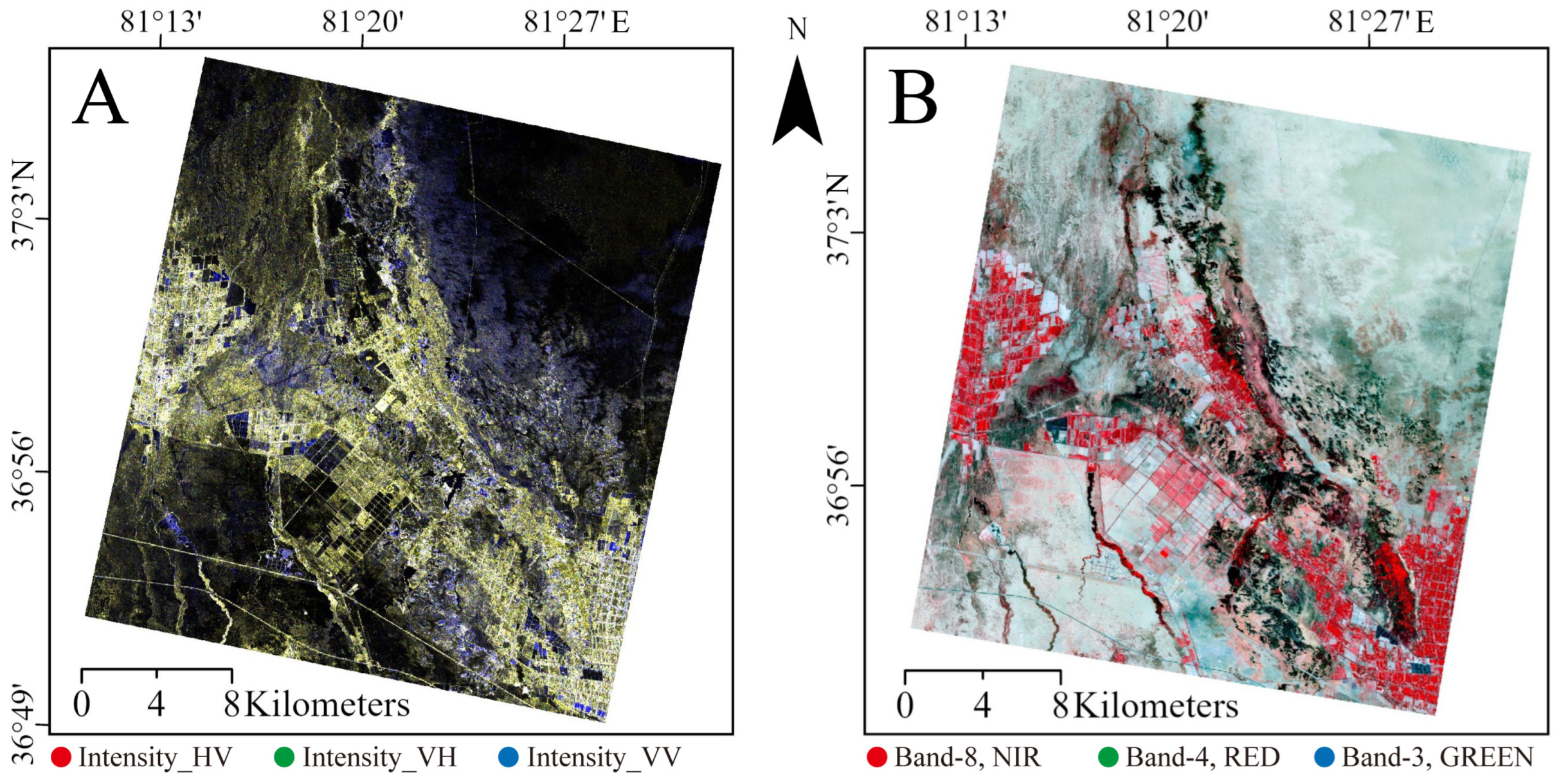
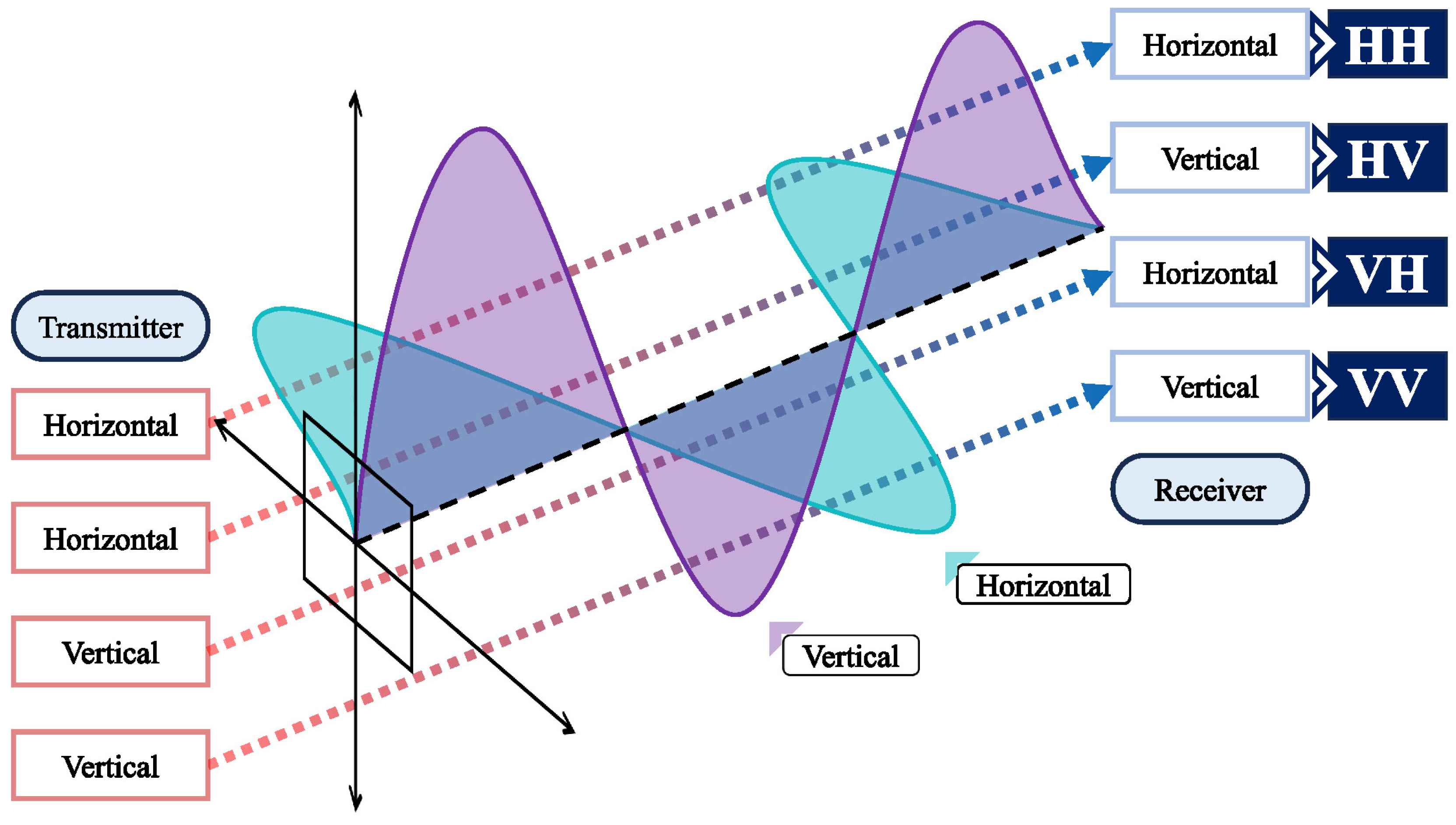
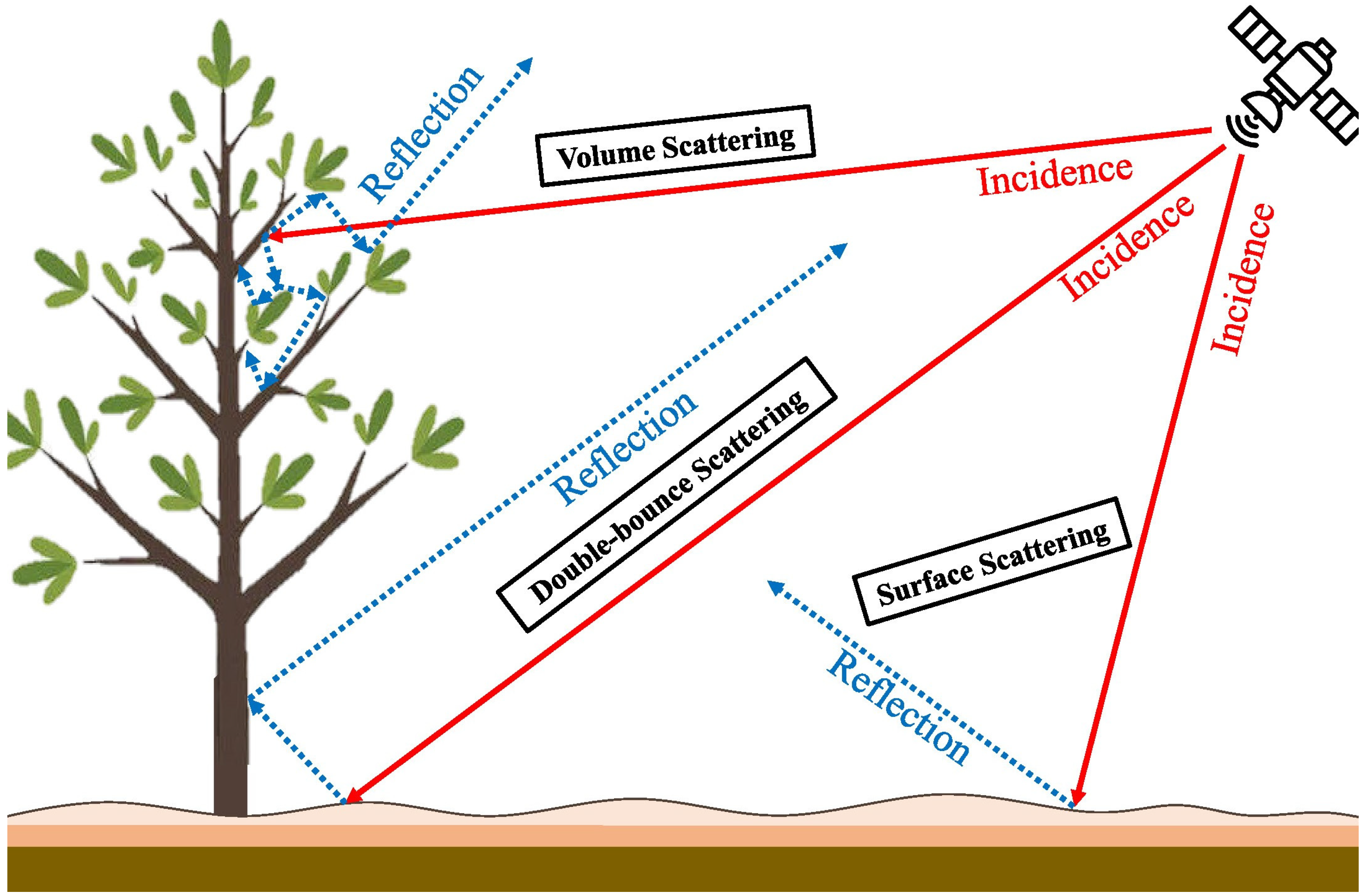


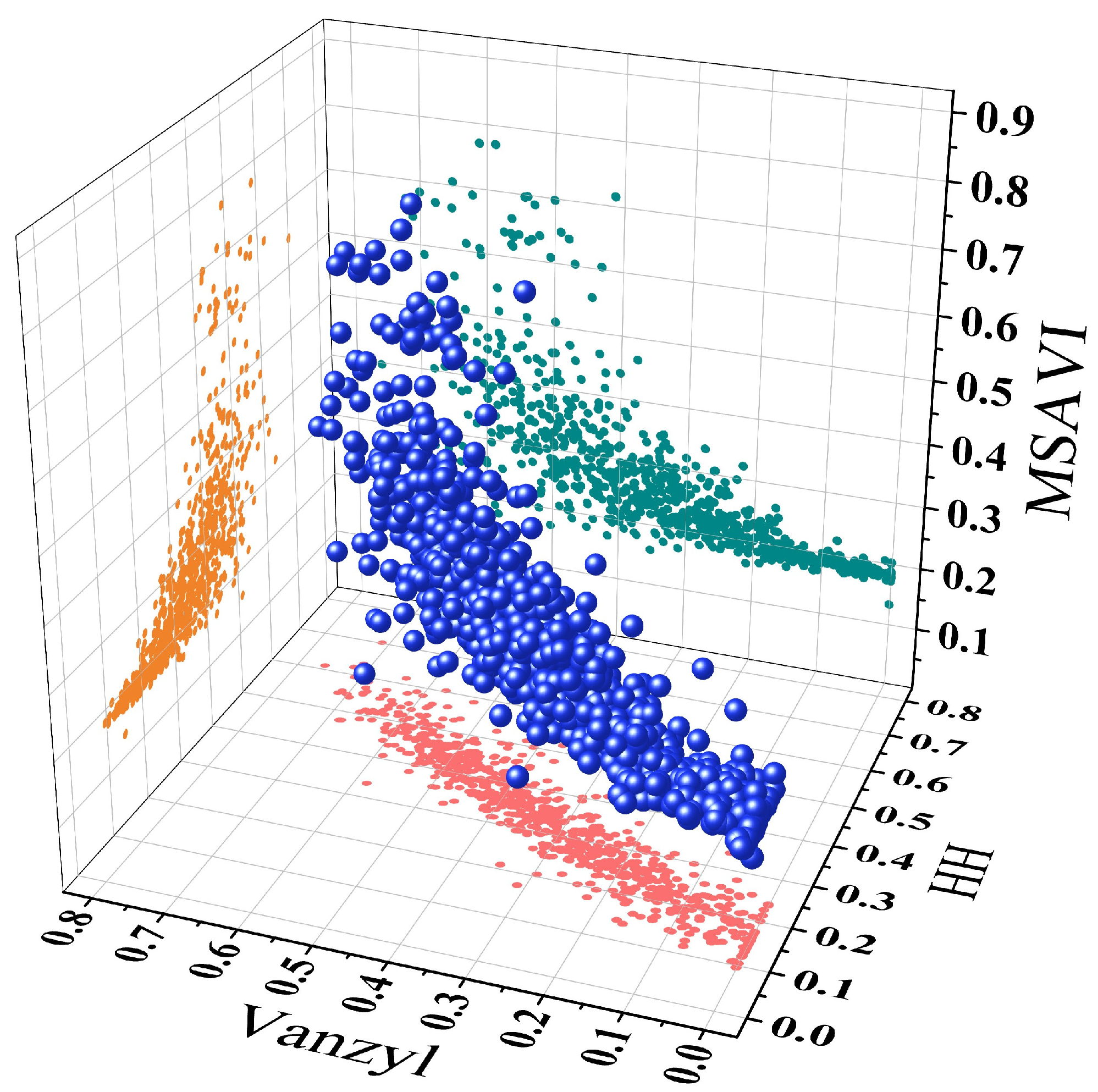
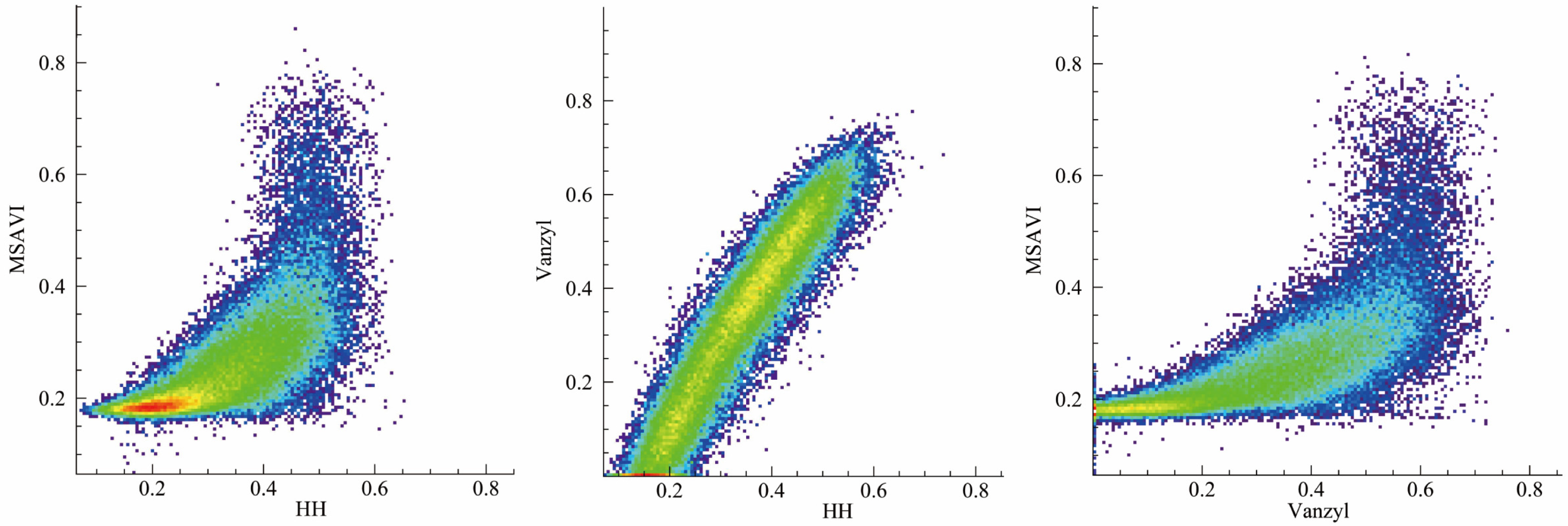
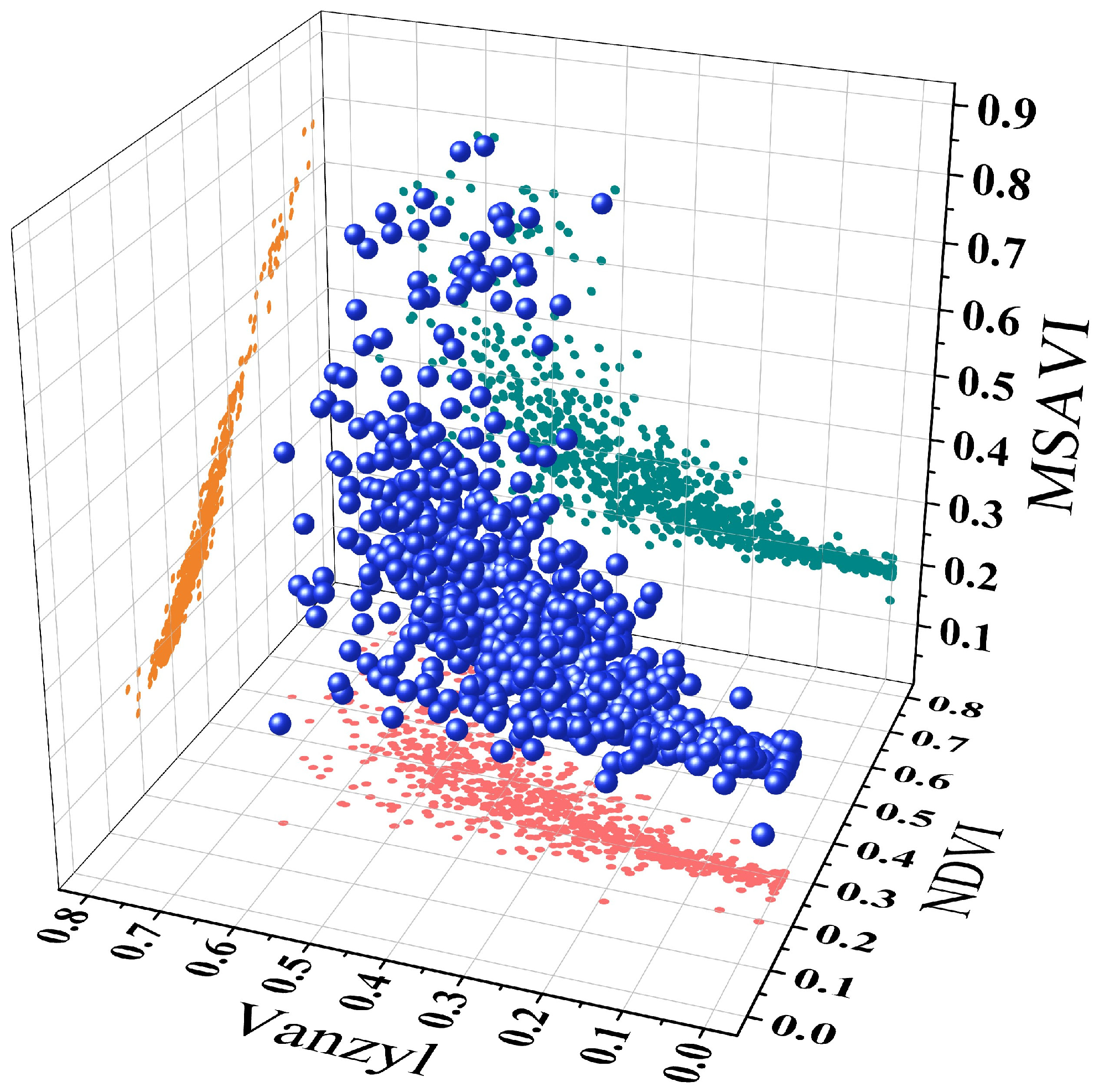

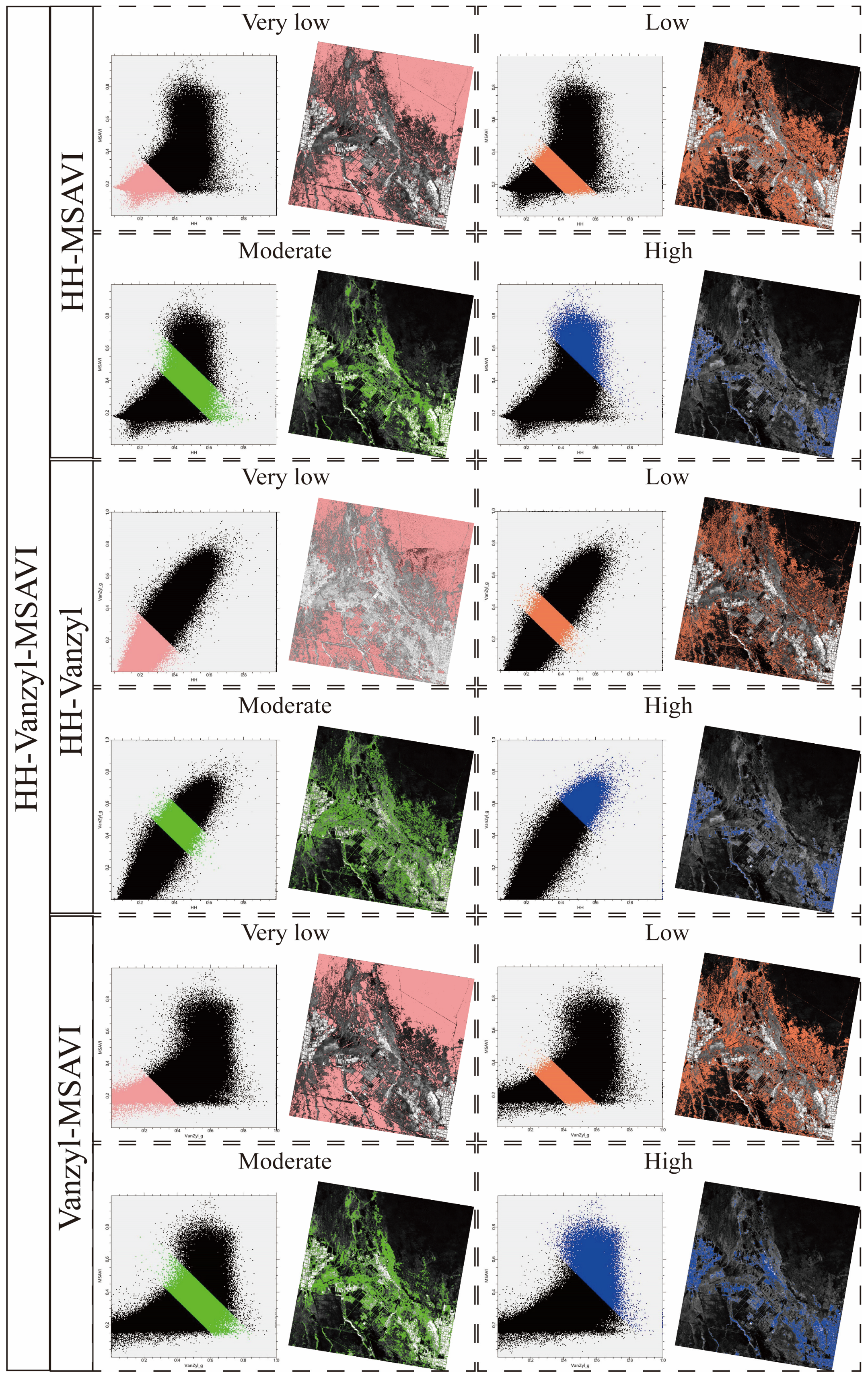
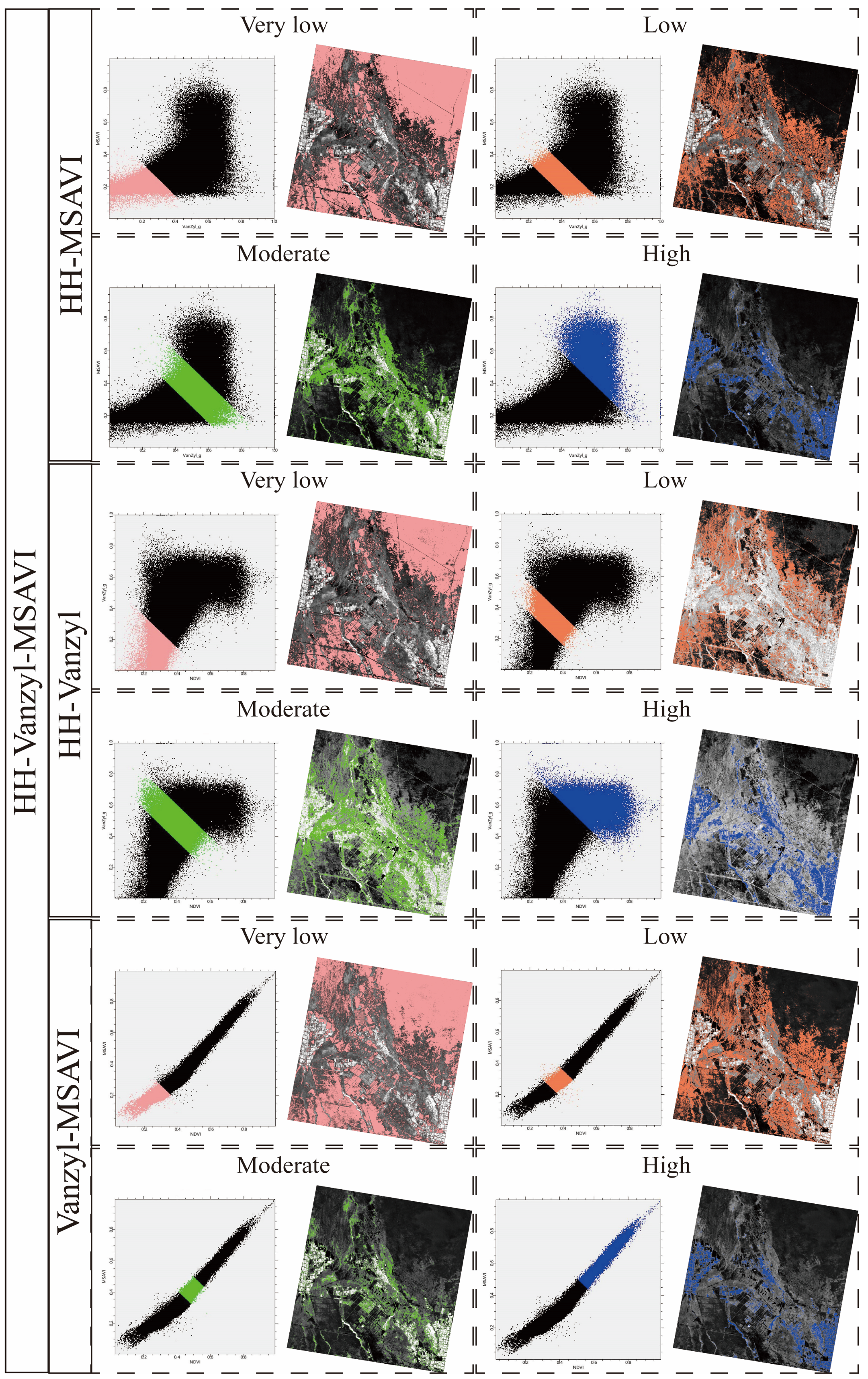

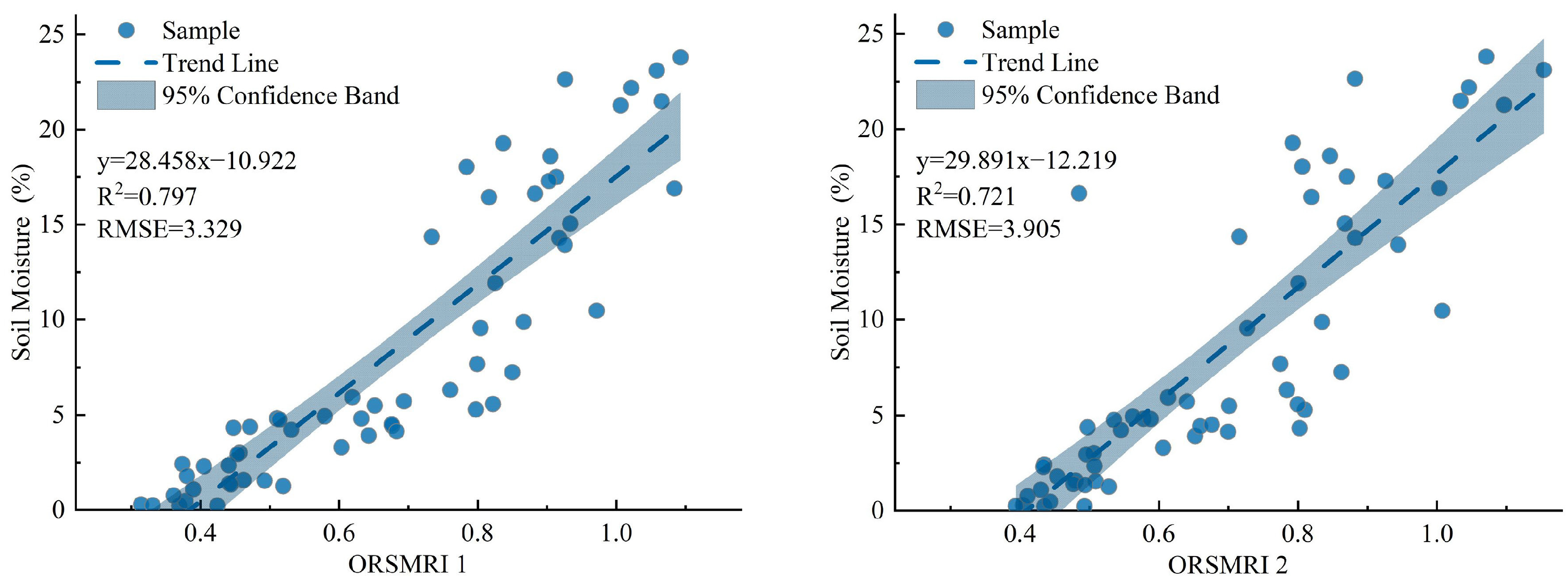

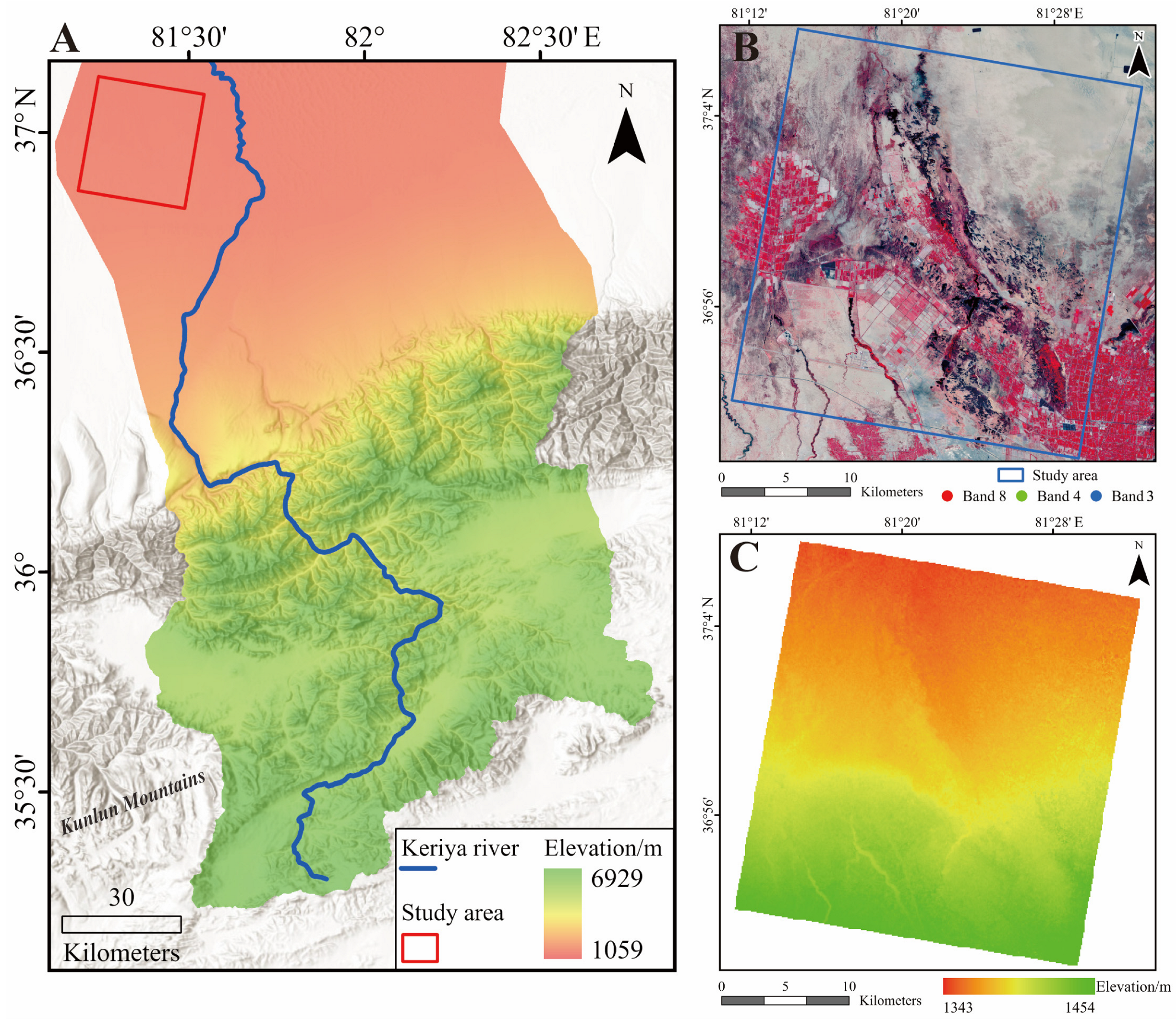
| Parameters | Data |
|---|---|
| Data acquisition data | 6 May 2022 |
| Radar center frequency | 5.4 GHz(C-band) |
| Product type | SLC |
| Incident angle | 41.0582–42.4470° |
| Acquisition type | Fine quad polarization |
| Observation and orbit direction | Right and descending |
| Size of a scene | 25 km × 25 km (range × azimuth) |
| Nominal resolution | 4.73 m × 5.49 m (range × azimuth) |
| Polarizations | HH, HV, VH, VV |
| Parameters | Data |
|---|---|
| Data acquisition data | 11 May 2022 |
| Satellite | Sentinel-2A |
| Product type | Level-1C |
| Number of bands | 13 spectral bands |
| Resolution | 10 m, 20 m, 60 m |
| Swath width | 290 km |
| Scene footprint | T44SNG, T44SNF |
| Polarimetric Decomposition Methods | Number of Components | Target Scattering Component |
|---|---|---|
| Sinclair | 3 | Sinclair _b, Sinclair _r, Sinclair _g |
| van Zyl | 3 | Vanzyl _b, Vanzyl _r, Vanzyl _g |
| Pauli | 3 | Pauli _b, Pauli _r, Pauli _g |
| Yang | 3 | Yang _b, Yang _r, Yang _g |
| Yamaguchi | 4 | Yamaguchi _b, Yamaguchi _r, Yamaguchi _hlx, Yamaguchi _g |
| Huynen | 3 | Huynen _r, Huynen _b, Huynen _g |
| Cloude | 3 | Cloude _b, Cloude _r, Cloude _g |
| Freeman–Durden | 3 | Freeman _b, Freeman _r, Freeman _g |
| Generalized Freeman–Durden | 3 | Generalized _b, Generalized _r, Generalized _g |
| Index | Formulation | Ref. |
|---|---|---|
| NDWI | [87] | |
| MNDWI | [88] | |
| NMDI | [83] | |
| NDMI | [89] | |
| SIMI | [90] | |
| SWCI | [91] | |
| NDVI | [92] | |
| GNDVI | [93] | |
| SAVI | [94] | |
| MSAVI | [95] |
| Retrieval Index | Points | Mean | SD | Pearson Correlation Coefficient | Significance Level | RMSE |
|---|---|---|---|---|---|---|
| ORSMRI 1 | Retrieved soil moisture | 8.79 | 7.03 | 0.71 | 0.001 | 3.0 |
| Measured soil moisture | 7.32 | 5.66 | ||||
| ORSMRI 2 | Retrieved soil moisture | 8.67 | 7.03 | 0.70 | 0.001 | 4.43 |
| Measured soil moisture | 7.32 | 5.83 |
Disclaimer/Publisher’s Note: The statements, opinions and data contained in all publications are solely those of the individual author(s) and contributor(s) and not of MDPI and/or the editor(s). MDPI and/or the editor(s) disclaim responsibility for any injury to people or property resulting from any ideas, methods, instructions or products referred to in the content. |
© 2025 by the authors. Licensee MDPI, Basel, Switzerland. This article is an open access article distributed under the terms and conditions of the Creative Commons Attribution (CC BY) license (https://creativecommons.org/licenses/by/4.0/).
Share and Cite
Aili, Y.; Nurmemet, I.; Li, S.; Lv, X.; Yu, X.; Aihaiti, A.; Qin, Y. Retrieval of Soil Moisture in the Yutian Oasis, Northwest China by 3D Feature Space Based on Optical and Radar Remote Sensing Data. Land 2025, 14, 627. https://doi.org/10.3390/land14030627
Aili Y, Nurmemet I, Li S, Lv X, Yu X, Aihaiti A, Qin Y. Retrieval of Soil Moisture in the Yutian Oasis, Northwest China by 3D Feature Space Based on Optical and Radar Remote Sensing Data. Land. 2025; 14(3):627. https://doi.org/10.3390/land14030627
Chicago/Turabian StyleAili, Yilizhati, Ilyas Nurmemet, Shiqin Li, Xiaobo Lv, Xinru Yu, Aihepa Aihaiti, and Yu Qin. 2025. "Retrieval of Soil Moisture in the Yutian Oasis, Northwest China by 3D Feature Space Based on Optical and Radar Remote Sensing Data" Land 14, no. 3: 627. https://doi.org/10.3390/land14030627
APA StyleAili, Y., Nurmemet, I., Li, S., Lv, X., Yu, X., Aihaiti, A., & Qin, Y. (2025). Retrieval of Soil Moisture in the Yutian Oasis, Northwest China by 3D Feature Space Based on Optical and Radar Remote Sensing Data. Land, 14(3), 627. https://doi.org/10.3390/land14030627





